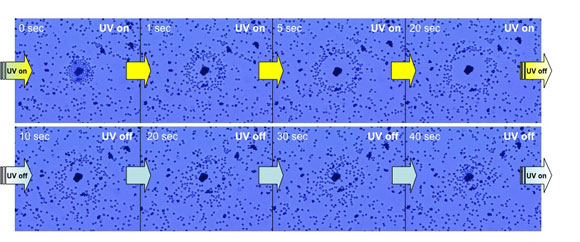| Posted: Jun 02, 2010 | |
Titanium dioxide powers light-driven micro- and nanomotors |
|
| (Nanowerk Spotlight) For nanotechnology researchers, movement at the nanoscale is a challenging problem and there is much to be learned from nature's motor systems. There are various approaches to creating self-propelled micro- and nanosized motors and one promising approach rests on catalytic conversion of chemical to mechanical energy – a process that is ubiquitous in biology, powering such important and diverse processes as cell division, skeletal muscle movement, protein synthesis, and transport of cargo within cells (see: "Catalytic nanotransporters for nanotechnology applications outside biological systems"). | |
| Self-propelled motion of synthetic materials can be useful in applications such as bottom-up assembly of structures, pattern formation, drug delivery at specific locations, etc. Researchers have now presented a novel and versatile light-driven catalytic micromotor system, which is the cleanest and simplest of its kind. | |
| "We use titanium dioxide to convert optical energy to mechanical energy via photocatalysis" Ayusman Sen tells Nanowerk. "The whole system consists only of titania, water, sometimes organics, and light input. The system is very forgiving, requiring no careful control of substrate concentration or catalyst conditioning, and is easily controllable by external light." | |
| Sen, a professor at the Department of Chemistry at Pennsylvania State University, together with his co-workers and collaborators from Ubaldo M. Córdova-Figueroa's research group at the University of Puerto Rico-Mayagüez, have reported their findings in a recent issue of Advanced Functional Materials ("Light-Driven Titanium-Dioxide-Based Reversible Microfireworks and Micromotor/Micropump Systems"). | |
| "Light-driven autonomous motion has only been reported recently" says Sen. "However, the previous systems were not catalytic and therefore stopped working eventually. Our system is catalytic and, in principle, should work as long as light is present." | |
| He explains that the photoactivity of titanium dioxide, which often is used for water treatment and decontamination purposes, comes from its hole–electron separation triggered by photons of energy equal to or higher than its bandgap. | |
| "The reactions produce more product molecules than the reactants consumed, making it possible to propel a titanium dioxide particle by the mechanism of osmotic propulsion or diffusiophoresis." | |
 |
|
| 'Microfireworks': Long UV exposure will cause silica particles to move back towards the titania particle slowly, most possibly as a result of thermal effects (Image: Dr. Sen, Pennsylvania State University) | |
| As the research team discusses in their paper, there are two categories of autonomous movement associated with titanium dioxide: the photo-induced motility of titanium dioxide particles (ranging from 0.2 to 2.5 µm) and the photo-induced reversible 'microfireworks' where silicon dioxide particles, which tend to gather around titanium dioxide particles, were shown to immediately move away from the titanium dioxide particles upon exposure to UV light, thereby creating an exclusion zone cleared of particles around each individual titanium dioxide particle. When the UV source is removed, the tracer particles pull back toward the titanium dioxide particle and form the aggregates again. | |
| "Overall, although the phenomena that we report are complex, the titanium dioxide based motor system we are proposing is highly active, inexpensive, clean and simple, requires little supply of fuels – e.g., alcohol – and produces no bubbles," says Sen. "It is easily controlled by UV light. With a little modification, e.g., dye sensitization, even visible light control could become possible." | |
| Underlying this research is a more fundamental attempt by scientists to design intelligent systems that mimic many aspects of biology. Sen notes that, much like living systems, this requires the continuous input of energy to fabricate organized systems driven far from equilibrium. | |
| "Intelligence requires: (a) Information and (b) the ability to process – i.e. act on – information. Information can be a light gradient while the information processor is a self-powered object. As shown in our paper, the result of information + information processing is emergent collective behavior, e.g. the formation of spatial and/or temporal assemblies of particles." | |
| Watch a video of the 'microfireworks'. It shows the photoactivity of a large titania particle in 1M methanol. The surrounding tracer particles are silica: | |
 By
Michael
Berger
– Michael is author of three books by the Royal Society of Chemistry:
Nano-Society: Pushing the Boundaries of Technology,
Nanotechnology: The Future is Tiny, and
Nanoengineering: The Skills and Tools Making Technology Invisible
Copyright ©
Nanowerk LLC
By
Michael
Berger
– Michael is author of three books by the Royal Society of Chemistry:
Nano-Society: Pushing the Boundaries of Technology,
Nanotechnology: The Future is Tiny, and
Nanoengineering: The Skills and Tools Making Technology Invisible
Copyright ©
Nanowerk LLC
|
|
|
Become a Spotlight guest author! Join our large and growing group of guest contributors. Have you just published a scientific paper or have other exciting developments to share with the nanotechnology community? Here is how to publish on nanowerk.com. |
|
